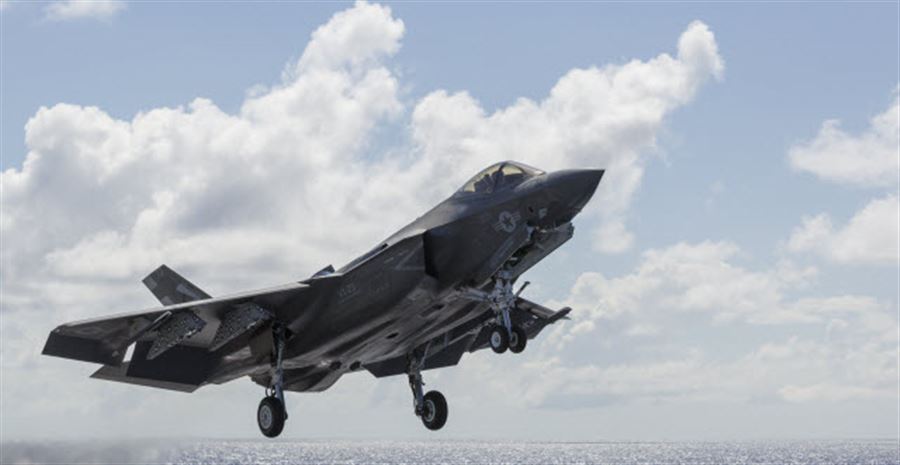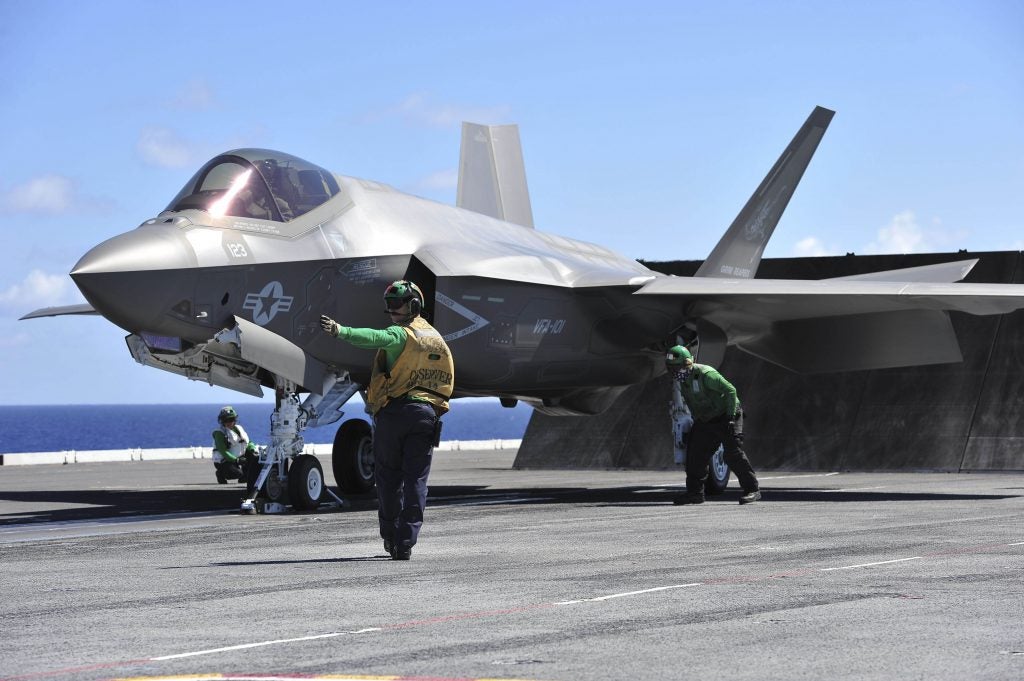By Kris Osborn
Carl Vinson air operations officer Cmdr. Joshua Hammond said carrier qualifications are important because they allow Carl Vinson to practice launching and recovering aircraft while helping qualify new pilots, according to a Navy statement from aboard the Carl Vinson.
“Being at sea for FRS (fleet replacement squadron) CQ gives us practice at what we do on deployment: launching and recovering aircraft,” Hammond. “We can’t always be underway with Carrier Air Wing, so these operations help us stay sharp and hone our craft while helping new pilots gain proficiency.” (Full Navy statement HERE)
Alongside the carrier qualifications on board the Carl Vinson, the Navy was also conducting testing of a special take-off mechanism known as the “hold back bar.” This is a technology which helps determine key elements of a carrier catapult launch such as the needed amount of thrust, speed and steadiness determined for a particular air frame.
Weapons preparation also continues to progress as part of the Navy’s push to bring the F-35C into combat. The F-35C has now been armed with a large, 5,000-pound load of weapons as part of a strategy to prepare the emerging aircraft for air-to-air engagements and air-to-ground attacks against enemy air defenses.
During developmental testing on the USS George Washington in the Atlantic Ocean last year, the F-35C took off with one GBU-31, two AIM-120s and four GBU-12s along with its 25mm gun mounted in a pod beneath the aircraft, Navy officials told Scout Warrior.
Being engineered for a carrier, the F-35C’s 51-foot wingspan is larger than the Air Force’s F-35A and Marine Corps’ F-35B short take-off-and-landing variants. The fighter is configured to carry 19,000 pounds of fuel and 18,000 pounds of weapons. It can fire two AIM-120 air-to-air missiles and two 2,000-pound Joint Direct Attack Munitions. The F-35C can reach speeds up to Mach 1.6 and travel more than 1,200 nautical miles.
The F-35C is also able to fire the AIM-9X along with other weapons; in the future it will have an ability to drop a Small Diameter Bomb II – a high-tech weapon now in development able to track and destroy moving targets from great distances using a tri-mode seeker. The SDB II uses millimeter wave, laser and infrared guidance technology.
Previous testing of the aircraft involved catapulting the stealth fighter off the aircraft carrier runway deck with a much lighter load of weapons; the full complement of armaments for the F-35C is designed to maximize its potential mission envelope and allow it to drop laser and GPS-guided precision Joint Direct Attack Munitions, use air-to-air weapons in the event that the aircraft needs to dogfight or destroy enemy drones and fire a 25mm gun.
— To Read Scout Warrior’s Previous F-35 weapons report, featuring the JSOW-C1 CLICK HERE —
Previous DT-III testing also evaluated new high-tech adjustments to the aircraft’s Helmet Mounted Display, or HMD. The sensors in the pilot’s Generation 3 HMD have been improved with new firmware to better enable pilots to target enemies and perform missions at night, Navy developers added.
Assessments of the F-35C, designed to bring the aircraft into operational service by 2018, have also included efforts to refine a precision-landing technology called Joint Precision Approach & Landing Systems, or JPALs.
JPALS, slated to be operational by 2019, works with the GPS satellite navigation system to provide accurate, reliable and high-integrity guidance for fixed- and rotary-wing aircraft, Navy statements said.
Also, Navy information described JPALS as a system featuring anti-jam protection to ensure mission continuity in hostile environments.
“JPALS is a differential GPS that will provide an adverse weather precision approach and landing capability,” a Navy statement said.
Prior to carrier-deck take-offs by two F-35Cs aboard the USS George Washington, the Navy extensively tested take-off and landing operations at two land facilities, Lakehurst, N.J. and Patuxent River, Md.

With a broad wingspan, reinforced landing gear, ruggedized structures and durable coatings, the Navy’s first of its kind F-35C is engineered for harsh shipboard conditions while avionics equip the pilot with real-time, spherical access to battlespace information and commanders at sea, in the air and on the ground with an instantaneous, high-fidelity single picture view of ongoing operations.
The Navy F-35C is the services’ first-ever stealthy carrier-launched multi-role attack fighter, engineered to perform a wider range of missions than any carrier aircraft has done before.
The emergence of a first-of-its kind carrier-launched stealth fighter is intended to give the Navy more combat attack flexibility and attack sophisticated enemy air defenses or fortified targets from a sea-based carrier. Such an ability can allow a maneuvering carrier to hold targets at risk from closer proximity if land-bases are far from the combat vicinity.
The new stealth Joint Strike Fighter will join the carrier air wing and fly alongside the F/A-18 Super Hornet, E2D Hawkeye surveillance planes and other aircraft. Over the next five years, the Navy plans to acquire as many as 60 or more of the new fighters, Navy officials have told Scout Warrior.
As it prepares for F-35C deployment, the Navy anticipates that the new aircraft will deploy to any one of a number of pressing hot-spots.
The F-35C is engineered with a new technology called Delta Flight Path which helps pilot land on a carrier deck more easily. Test pilots and engineers credited the F-35C’s Delta Flight Path technology with significantly reducing pilot workload during the approach to the carrier, increasing safety margins during carrier approaches and reducing touchdown dispersion.
Carrier landing is never easy as pilots must account for the wind-speed, atmospheric conditions and speed of the ship. Pilots follow a yellow light on the flight deck of the ship called the Freshnel Lens to help the trajectory of the approach, called their glide slope, Navy experts have explained to Scout Warrior.
The Fresnel Lens includes a vertical row of yellow lights between two horizontal rows of green lights. Using a series of lights and mirrors, a pilot’s approach is reflected by the position of the yellow light in relation to the green lights above and below, displaying whether the aircraft is on the right “center line” or “glide slope,” Navy pilots have explained.

If a pilot is on glide slope, he will see a centered amber ball in between the horizontal green lights; If he goes high on glide slope, he will see the ball rise above the green lights. If he goes below glide slope, he will see the ball fall below the green lights.
— To Read Scout Warrior’s Previous Special “Landing an F-35C on an Aircraft Carrier” CLICK HERE —
Also, in order to properly align for an approach to the flight deck — about three-quarters of a mile away, pilots make a sharp, descending 180-degree turn to slow the aircraft and begin descending from about 600 feet, Take-off is also intense; Aircraft are able to reach speeds up to 160 knots in about 2.5 seconds as a result of being thrust forward by the steam catapult.
The steam catapult generates 520 PSI (pounds per square inch) of pressure pushing pistons forward. The pistons push cylinders connected to a shuttle attached to a launch bar, which pulls the aircraft forward, Navy officials explained.
Upon landing, the aircraft catches an arresting cable four to six inches above the deck of the carrier; hydraulic fluid controls the pace of deceleration for the aircraft, Navy pilots explained.
A hook lowers from the back end of the F-35C aircraft, designed to catch the cable and slow down the plane. In order to maintain its stealth configuration, the aircraft’s hook is internal to the airframe.
On all the legacy systems, the tail hook sits up underneath the engine externally. Upon landing, three doors open up and allow the tail hook to fall down, Navy pilots said.
The aircraft also needs to be able to withstand what’s called a “free flight,” a situation where the pilot receives a late wave off to keep flying after the hook on the airplane has already connected with the wire, pilots added.
The aircraft has gone through several rounds of testing to advance what’s called carrier integration and carrier qualification – an effort to seamlessly integrate the new aircraft into the carrier platform and carrier air wing, service officials have explained.
Stealthy F-35C carrier aircraft, having a lower radar signature, are expected to deliver advanced attack and air-to-air and intelligence, surveillance and reconnaissance platforms, able to perform a wider range of operations without being detected by an enemy.

The aircraft is part of a broader Navy strategy to be well equipped in the event that it needs to engage in massive, major-power war against a near-peer adversary such as Russia and China known to have advanced air-defenses and air-to-air platforms.
The F-35C – the Navy’s and Marine Corps’ carrier-suitable variant (CV) – is designed to combined unprecedented at-sea stealth with fighter speed and agility, fused targeting, cutting-edge avionics, advanced jamming, network-enabled operations and advanced sustainment.
In a previously released document described as the “Naval Aviation Vision,” the F-35C is described as being engineered with reinforced landing gear and durable coatings to allow the F-35C to withstand harsh shipboard conditions while delivering a lethal combination of fighter capabilities to the fleet.
In recent years, the F-35 has been completing stages of Developmental Testing III, or DT-III, as the third of three at-sea test phases for the F-35C. Naval aircraft are slated to go through DT-I, -II and -III test phases in order to ensure the development of aircraft meets specifications and properly identifies mission critical issues sufficiently early in the test phase.
Two F-35C Lightning II carrier variants conducted their first arrested landings aboard USS Dwight D. Eisenhower (CVN 69) off the coast of the eastern United States on Oct. 2, 2015.
By 2025, the Navy’s aircraft carrier-based air wings will consist of a mix of F-35C, F/A-18E/F Super Hornets, EA-18G Growlers electronic attack aircraft, E-2D Hawkeye battle management and control aircraft, MH-60R/S helicopters and Carrier Onboard Delivery logistics aircraft such as the emerging Navy Osprey tiltrotor aircraft variant.
Lockheed Martin is the aircraft contractor and Pratt & Whitney is the engine contractor. Several reports, including on from “War is Boring,” cite the F-35C cost per plane as more than $337 million.



Comments
No comment